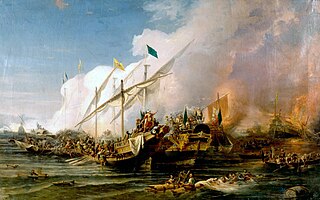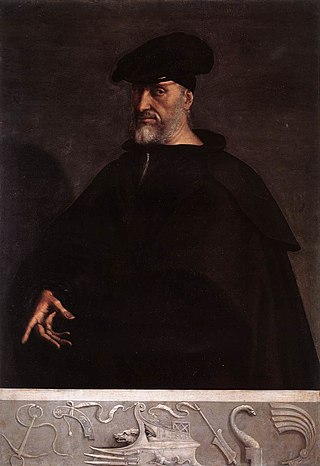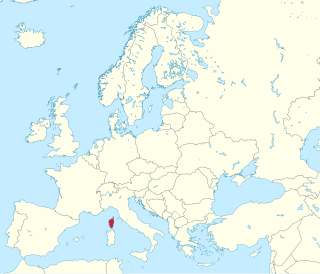
The Battle of Lepanto was a naval engagement that took place on 7 October 1571 when a fleet of the Holy League, a coalition of Catholic states arranged by Pope Pius V, inflicted a major defeat on the fleet of the Ottoman Empire in the Gulf of Patras. The Ottoman forces were sailing westward from their naval station in Lepanto when they met the fleet of the Holy League which was sailing east from Messina, Sicily.

The Battle of Preveza was a naval engagement that took place on 28 September 1538 near Preveza in the Ionian Sea in northwestern Greece between an Ottoman fleet and that of a Holy League. The battle was an Ottoman victory which occurred in the same area in the Ionian Sea as the Battle of Actium in 31 BC. It was one of the three largest sea battles that took place in the sixteenth century Mediterranean, along with the Battle of Djerba and the Battle of Lepanto.

Andrea Doria, Prince of Melfi was an Italian statesman, condottiero, and admiral, who played a key role in the Republic of Genoa during his lifetime.

The Republic of Genoa was a medieval and early modern maritime republic from the years 1099 to 1797 in Liguria on the northwestern Italian coast. During the Late Middle Ages, it was a major commercial power in both the Mediterranean and Black Sea. Between the 16th and 17th centuries, it was one of the major financial centres in Europe.
Murat Reis the Elder was an Ottoman privateer and admiral, who served in the Ottoman Navy. He is regarded as one of the most important Barbary corsairs.

The Italian War of 1551–1559 began when Henry II of France declared war against Holy Roman Emperor Charles V with the intent of recapturing parts of Italy and ensuring French, rather than Habsburg, domination of European affairs. The war ended following the signing of the Treaty of Cateau-Cambrésis between the monarchs of Spain, England and France in 1559. Historians have emphasized the importance of gunpowder technology, new styles of fortification to resist cannon fire, and the increased professionalization of the soldiers.

Hayreddin Barbarossa, also known as Hayreddin Pasha, Hızır Hayrettin Pasha, and simply Hızır Reis, was an Ottoman corsair and later admiral of the Ottoman Navy. Barbarossa's naval victories secured Ottoman dominance over the Mediterranean during the mid-16th century.

The Ottoman Navy or The Imperial Navy, also known as the Ottoman Fleet, was the naval warfare arm of the Ottoman Empire. It was established after the Ottomans first reached the sea in 1323 by capturing Praenetos, the site of the first Ottoman naval shipyard and the nucleus of the future navy.
Salah Rais was the 7th King of Algiers, an Ottoman privateer and admiral. He is alternatively referred to as Sala Reis, Salih Rais, Salek Rais and Cale Arraez in several European sources, particularly in Spain, France and Italy.

The siege of Nice occurred in 1543 and was part of the Italian War of 1542–46 in which Francis I and Suleiman the Magnificent collaborated as part of the Franco-Ottoman alliance against the Holy Roman Emperor Charles V, and Henry VIII of England. At that time, Nice was under the control of Charles III, Duke of Savoy, an ally of Charles V. This is part of the 1543–1544 Mediterranean campaign of Barbarossa.

The Invasion of Corsica of 1553 occurred when French, Ottoman, and Corsican exile forces combined to capture the island of Corsica from the Republic of Genoa.

The siege of Castelnuovo was an engagement during the Ottoman-Habsburg struggle for control of the Mediterranean, which took place in July 1539 at the walled town of Castelnuovo, present-day Herceg Novi, Montenegro. Castelnuovo had been conquered by elements of various Spanish tercios the year before during the failed campaign of the Holy League against the Ottoman Empire in Eastern Mediterranean waters. The walled town was besieged by land and sea by a powerful Ottoman army under Hayreddin Barbarossa, who offered an honourable surrender to the defenders. These terms were rejected by the Spanish commanding officer Francisco de Sarmiento and his captains even though they knew that the Holy League's fleet, defeated at the Battle of Preveza, could not relieve them. During the siege, Barbarossa's army suffered heavy losses due to the stubborn resistance of Sarmiento's men. Even the Venetian refused the promised naval link to Castelnuovo with the supplies and reinforcements; after a general troop parliament, the commanding officer Francisco de Sarmiento asked his captains what his answer should be to Barbarossa's offer to surrender. The captains responded: "Que vengan cuando quieran". However, Castelnuovo eventually fell into Ottoman hands and almost all the Spanish defenders, including Sarmiento, were killed. The loss of the town ended the Christian attempt to regain control of the Eastern Mediterranean. The courage displayed by the Old Tercio of Naples during this last stand, however, was praised and admired throughout Europe and was the subject of numerous poems and songs.

The Ottoman wintering in Toulon occurred during the winter of 1543–44, following the Franco-Ottoman Siege of Nice, as part of the combined operations under the Franco-Ottoman alliance. It involved the fleet commanded by Ottoman admiral Hayreddin Barbarossa.

The capture of Mahdia was an amphibious military operation that took place from June to September, 1550, during the struggle between the Ottoman Empire and the Spanish Habsburgs for the control of the Mediterranean. A Spanish naval expedition under the command of the Genoese condottiero and admiral Andrea Doria and the Spaniard Bernardino de Mendoza, supported by the Knights of Malta under their Grand Master Claude de la Sengle, besieged and captured the Ottoman stronghold of Mahdia or Mahdiye, defended by the Ottoman Admiral Turgut Reis, known as Dragut, who was using the place as a base for his piratical activities throughout the Spanish and Italian coasts. Mahdia was abandoned by Spain three years later, and all its fortifications were demolished to avoid a re-occupation of the city by the Ottomans.

Dragut was an Ottoman corsair, naval commander, governor, and noble. Under his command, the Ottoman Empire's maritime power was extended across North Africa. Recognized for his military genius, and as being among "the most dangerous" of corsairs, Dragut has been referred to as "the greatest pirate warrior of all time", "undoubtedly the most able of all the Turkish leaders", and "the uncrowned king of the Mediterranean". He was nicknamed "the Drawn Sword of Islam". He was described by a French admiral as "a living chart of the Mediterranean, skillful enough on land to be compared to the finest generals of the time" and that "no one was more worthy than he to bear the name of king". Hayreddin Barbarossa, who was his mentor, stated that Dragut was ahead of him "both in fishing and bravery".

The Battle of Girolata was a naval action fought between Genoese, Spanish, and Ottoman ships on 15 June 1540 in the Gulf of Girolata, on the west coast of the island of Corsica, amidst the war between Charles V of Spain and Suleiman the Magnificent. A Spanish squadron of 21 galleys led by the Genoese Gianettino Doria and the Spaniard Berenguer de Requesens surprised an Ottoman squadron of 11 galleys, anchored at Girolata, led by the Ottoman admiral Dragut, whom the commander of the Ottoman Navy, Hayreddin Barbarossa, had committed to raid the Italian coast after his victories in the Adriatic Sea the year before. As the crews of the Ottoman warships were ashore, distributing the booty from recent raids, the Spanish-Genoese fleet easily overtook them, taking all 11 Ottoman galleys and making 1,200 prisoners, among them Dragut, who was carried to Genoa and put, together with his captains, to row in Andrea Doria's galleys.

The Genoese navy was the naval contingent of the Republic of Genoa's military. From the 11th century onward the Genoese navy protected the interests of the republic and projected its power throughout the Mediterranean and Black Seas. It played a crucial role in the history of the republic as a thalassocracy and a maritime trading power.

The Battle of Capo d'Orso, sometimes known as the Battle of Cava and the Battle of Amalfi, was a naval engagement taking place from 5:00 PM to 9:00 PM on April 28 1528, during the War of the League of Cognac. A French fleet inflicted a crushing defeat on the fleet of the Kingdom of Naples under Spanish command in the Gulf of Salerno, where Spanish forces trying to break the French blockade of the city met the French fleet.

The Battle of Pianosa was a naval engagement which took place on 25 April 25, 1519, when a Genoese fleet severely defeated the flotilla of the Tunisia-based Barbary corsair Kaid Ali in the Tyrrhenian Sea, in view of the island of Elba. The battle broke the back of one of the rising corsair bases on the Barbary Coast, Bizerte, and established Andrea Doria as among the foremost captains in the Mediterranean.
The Battle of Chios of 1621 was a naval battle between a Spanish and Italian fleet and an Ottoman-Barbary fleet near the island of Chios. It concluded with a Christian victory.

















